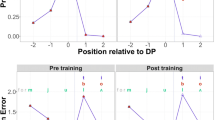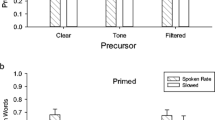Summary
Two incentives underlie the present study on speech-error detection and correction. First, this area of research has up to now almost completely been approached through experimental techniques. Since it is not at all clear whether speakers' detection and correction behaviour is identical inside and outside the laboratory, a comparison is made between experimental and naturalistic data. While the experimental materials are taken from the literature, the naturalistic findings are based upon the analysis of a corpus of more than 6,000 German slips of the tongue. It is shown that the same trends emerge in both data sets, thereby confirming the ecological validity of the experimental, and the reliability of the naturalistic, results. Secondly, the question arises as to the reasons for error correction and its occasional failure. Two working hypotheses are explored. Speakers fail to correct their errors because they have not detected them or because they assume that the error does not interfere with the listener's decoding process. The former reason is understood as a productive, the latter as a perceptual, constraint on the correction of self-produced errors. The empirical analysis discloses a large overlap between the effects of perceptual and productive constraints. However, whereas perceptual constraints can be subsumed under productive ones, the reverse is not possible. On the basis of this outcome it is argued that productive constraints are primary, and perceptual constraints secondary, reference points for error correction. Although the empirical data do not require the postulation of perceptual constraints, it is suggested that both speaker- and listenerbased aspects form part of à highly integrated processing system.
Similar content being viewed by others
References
Abramovici, S. (1983). Errors in proofreading: Evidence for syntactic control of letter processing?Memory & Cognition, 11, 258–261.
Berg, T. (1986). The aftermath of error occurrence: Psycholinguistic evidence from cut-offs.Language & Communication, 6, 195–213.
Berg, T. (1988).Die Abbildung des Sprachproduktionsprozesses in einem Aktivationsflussmodell. Untersuchungen an deutschen und englischen Versprechern. Tübingen: Niemeyer.
Berg, T. (1989). On the internal structure of polysyllabic monomorphemic words: The case for superrimes.Studia Linguistica, 43, 5–33.
Bock, K., & Miller, C. A. (1991). Broken agreement.Cognitive Psychology, 23, 45–93.
Bond, Z. S., & Small, L. H. (1983). Voicing, vowel, and stress mispronunciations in continuous speech.Perception & Psychophysics, 34, 470–474.
Bond, Z. S., & Small, L. H. (1984). Detecting and correcting mispronunciations: A note on methodology.Journal of Phonetics, 12, 277–283.
Brédart, S. (1991). Word interruption in self-repairing.Journal of Psycholinguistic Research, 20, 123–138.
Brown, E. K. (1980). Grammatical incoherence. In H. W. Dechert & M. Raupach (Eds.),Temporal variables in speech (pp. 27-37). The Hague: Mouton.
Brown, P. M., & Dell, G. S. (1987). Adapting production to comprehension: The explicit mention of instruments.Cognitive Psychology, 19, 441–472.
Cohen, A. (1980). Correcting of speech errors in a shadowing task. In V. A. Fromkin (Ed.),Errors in linguistic performance (pp. 157–163). New York: Academic Press.
Cole, R. A. (1973). Listening for mispronunciations. A measure of what we hear during speech.Perception & Psychophysics, 11, 153–156.
Cole, R. A., & Jakimik, J. (1980). How are syllables used to recognize words?Journal of the Acoustical Society of America, 67, 965–970.
Cole, R. A., Jakimik, J., & Cooper, W. (1978). Perceptibility of phonetic features in fluent speech.Journal of the Acoustical Society of America, 64, 44–56.
Cooper, W. E., Tye-Murray, N., & Nelson L. J. (1987). Detection of missing words in spoken text.Journal of Psycholinguistic Research, 16, 233–240.
Corcoran, D. W. J. (1967). Acoustic factor in proofreading.Nature, 214, 851–852.
Cutler, A. (1980). Productivity in word formation.Papers from the 16th annual regional meeting of the Chicago Linguistic Society (pp. 45–51). Chicago: Chicago Linguistic Society.
Cutler, A. (1983). Speakers' conceptions of the function of prosody. In Anne Cutler & D. Robert Ladd (Eds.),Prosody: models and measurements (pp. 79–91). Heidelberg: Springer.
Cutler, A. (1987). Speaking for listening. In A. Allport, D. G. MacKay, W. Prinz, & E. Scheerer (Eds.),Language perception and production: Relationships between listening, speaking, reading, and writing (pp. 23–40). London: Academic Press.
Cutler, A., & Norris, D. G. (1988). The role of strong syllables in segmentation for lexical access.Journal of Experimental Psychology: Human Perception and Performance, 14, 113–121.
Davis, S. M. (1989). On a non-argument for the rhyme.Journal of Linguistics, 25, 211–217.
Dietrich, R. (1982). Selbstkorrekturen. Fallstudien zum mündlichen Gebrauch des Deutschen als Fremdsprache durch Erwachsene.Zeitschrift für Literaturwissenschaft und Linguistik, 12, 120–149.
Ferber, R. (1991). Slip of the tongue or slip of the ear? On the perception and transcription of naturalistic slips of the tongue.Journal of Psycholinguistic Research, 20, 105–122.
Healy, A. F. (1981). The effects of visual similarity on proofreading for misspellings.Memory & Cognition, 9, 453 -460.
Hotopf, W. H. N. (1979). Review of re-issue of Meringer & Mayer (1895).Quarterly Journal of Experimental Psychology, 31, 555–557.
Lackner, J. R. (1980). Speech production: Correction of semantic and grammatical errors during speech shadowing. In V. A. Fromkin (Ed.),Errors in linguistic performance (pp. 149–155). New York: Academic Press.
Lackner, J. R., & Tuller, B. H. (1979). Roles of efference monitoring in the detection of self-produced speech errors. In W. E. Cooper & E. C. T. Walker (Eds.),Sentence processing. Psycholinguistic studies presented to Merrill Garrett (pp. 281–294). Hillsdale, NJ: Lawrence Erlbaum Associates.
Laver, J. (1969). The detection and correction of slips of the tongue. Reprinted in V. A. Fromkin (Ed.),Speech errors as linguistic evidence (pp. 132–143). The Hague: Mouton, 1973.
Levelt, W. J. M. (1983). Monitoring and self-repair in speech.Cognition, 14, 41–104.
Levelt, W. J. M., & Cutler, A. (1983). Prosodic marking in speech repair.Journal of Semantics, 2, 205–217.
MacKay, D. G. (1987).The organization of perception and action. A theory for language and other cognitive skills. New York: Springer.
Marshall, R. C., Rappaport, B. Z., & Garcia-Bunuel, L. (1985). Selfmonitoring behavior in a case of severe auditory agnosia with aphasia.Brain and Language, 24, 297–313.
Marslen-Wilson, W., & Welsh, A. (1978). Processing interactions and lexical access during word recognition in continuous speech.Cognitive Psychology, 10, 29–63.
Meringer, R. (1908).Aus dem Leben der Sprache. Versprechen, Kindersprache, Nachahmungstrieb. Berlin: Behrs.
Nooteboom, S. G. (1980). Speaking and unspeaking. Detection and correction of phonological and lexical errors in spontaneous speech. In V. A. Fromkin (Ed.),Errors in linguistic performance (pp. 87–95). New York: Academic Press.
Ottevanger, I. B. (1983). Preserved mispronunciations and the interpretation of results obtained in a shadowing task. In M. R. P. van den Broecke, V. van Heuven, & W. Zonneveld (Eds.),Sound structures. Studies for Antonie Cohen (pp. 195–204). Dordrecht: Foris.
Rabbitt, P., Cumming, G., & Vyas, S. (1978). Some errors of perceptual analysis in visual search can be detected and corrected.Quarterly Journal of Experimental Psychology, 30, 319–332.
Rath, R. (1975). Korrektur und Anakoluth im gesprochenen Deutsch.Linguistische Berichte, 37, 1–12.
Shattuck-Hufnagel, S. (1983). Sublexical units and suprasegmental structure in speech production planning. In P. F. MacNeilage (Ed.),The production of speech (pp. 109–136). New York: Springer.
Shattuck-Hufnagel, S. (1987). The role of word-onset consonants in speech production planning: New evidence from speech error patterns. In E. Keller & M. Gopnik (Eds.),Motor and sensory processes of language (pp. 17–51). Hillsdale, NJ: Lawrence Erlbaum.
Stemberger, J. P. (1983).Speech errors and theoretical phonology. A review. Bloomington: Indiana University Linguistics Club.
Tent, J., & Clark, J. E. (1980). An experimental investigation into the perception of slips of the tongue.Journal of Phonetics, 8, 317–325.
Author information
Authors and Affiliations
Rights and permissions
About this article
Cite this article
Berg, T. Productive and perceptual constraints on speech-error correction. Psychol. Res 54, 114–126 (1992). https://doi.org/10.1007/BF00937140
Received:
Accepted:
Issue Date:
DOI: https://doi.org/10.1007/BF00937140




